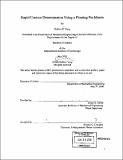| dc.contributor.advisor | Sanjay E. Sarma. | en_US |
| dc.contributor.author | Yang, Stallion E. (Stallion Ease), 1977- | en_US |
| dc.contributor.other | Massachusetts Institute of Technology. Dept. of Mechanical Engineering. | en_US |
| dc.date.accessioned | 2006-02-02T18:47:18Z | |
| dc.date.available | 2006-02-02T18:47:18Z | |
| dc.date.copyright | 2000 | en_US |
| dc.date.issued | 2000 | en_US |
| dc.identifier.uri | http://hdl.handle.net/1721.1/31093 | |
| dc.description | Thesis (S.B.)--Massachusetts Institute of Technology, Dept. of Mechanical Engineering, 2000. | en_US |
| dc.description | Includes bibliographical references (leaf 21). | en_US |
| dc.description.abstract | The exponential growth of computer and information technologies have drastically simplified the transfer of geometric information from the minds of designers to physical embodiments of design concepts. For example, it is now possible for designers to transform a complex design idea into a part or model on his desk within a few hours with the use of CAD software and CNC machining. This reduction in thought-to- part time begs the question of how the part-to-thought process can be sped up. Currently, if a designer needs to determine the geometry of a complex contour, he has to use either a phase-change material or some sort of optical scanning method. However, the use of phase-change materials can be awkward and does not permit digital manipulation of the geometric information. While optical methods do not have these short falls, it's cost is often prohibitive and it faces geometric limitations. The objective of this thesis is to design and test an alternative method of contour determination, using a floating pin matrix which can move to conform to the shape of the contour and output the position of each pin to a computer. The pin matrix is a bed of tightly packed cylinders that can move in the axial direction independent of each other. When the pin matrix is pushed against a certain surface, each pin moves into contact with the surface, correlating the axial displacement of each pin to the height of the surface at the point of contact. Mapping the axial displacement (z-coordinate) of the pins to their known location on the matrix (x- and y- coordinates) yields a complete picture of contour. While determining the axial displacement of a moving pin is a rather simple and trivial task, the fact that the pins need to be tightly packed in large numbers to provide a good resolution greatly complicates the task. The solution that was arrived at in this thesis involves using the moving pins as part of a "reverse potentiometer" and using two parallel plates as electrical leads that contact each and every one of the pins. The pins and the parallel plates are thus utilized both for physical function of the device and the measurement of the displacement, halving the amount of necessary components. A prototype of the device was constructed and tested to determine the feasibility of the pin matrix system. Although the prototype only incorporated one pin, it was demonstrated that the pin matrix concept is feasible as long as issues of contact resistance between the parallel plates and the pins can be resolved. | en_US |
| dc.description.statementofresponsibility | by Stallion E. Yang. | en_US |
| dc.format.extent | 21 leaves | en_US |
| dc.format.extent | 1066410 bytes | |
| dc.format.extent | 1065914 bytes | |
| dc.format.mimetype | application/pdf | |
| dc.format.mimetype | application/pdf | |
| dc.language.iso | eng | en_US |
| dc.publisher | Massachusetts Institute of Technology | en_US |
| dc.rights | M.I.T. theses are protected by copyright. They may be viewed from this source for any purpose, but reproduction or distribution in any format is prohibited without written permission. See provided URL for inquiries about permission. | en_US |
| dc.rights.uri | http://dspace.mit.edu/handle/1721.1/7582 | |
| dc.subject | Mechanical Engineering. | en_US |
| dc.title | Rapid contour determination using a floating pin matrix | en_US |
| dc.type | Thesis | en_US |
| dc.description.degree | S.B. | en_US |
| dc.contributor.department | Massachusetts Institute of Technology. Department of Mechanical Engineering | |
| dc.identifier.oclc | 48095500 | en_US |

